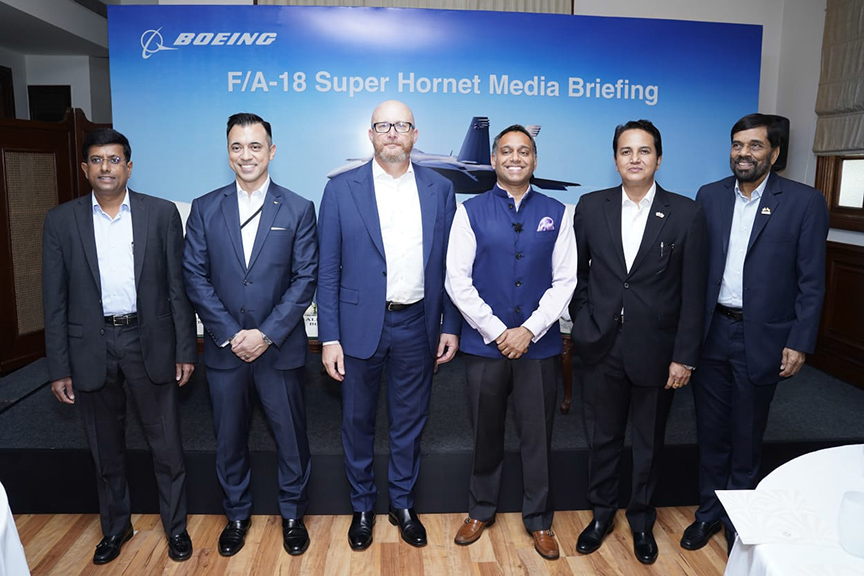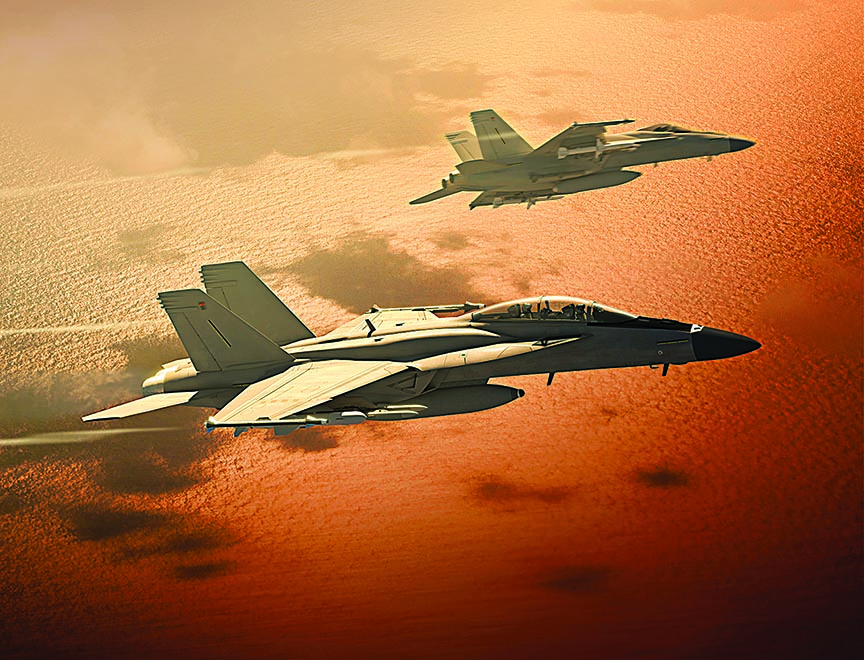Boeing unveils Aatmanirbhar Bharat strategy for India’s defense industry
- Potential economic impact of $3.6 billion over 10 years to Indian economy with the F/A-18 Super Hornet as India’s carrier-based fighter
- Continued investments in manufacturing, engineering & technology transfer, sustainment, training and skilling and infrastructure
- Work and technology transfer for the advanced F/A-18 Super Hornet fighter jets with Indian industry is proposed
New Delhi, August 24. Boeing plans to further strengthen its Make in India initiatives, building on a successful track record of contributing to India’s indigenous aerospace and defence ecosystem.

As part of this effort, Boeing anticipates $3.6 billion in economic impact to the Indian aerospace and defense industry over the next 10 years, with the F/A-18 Super Hornet as India’s next carrier-based fighter. The economic impact would be over and above Boeing’s current offset obligations and plans in the country.
“As a trusted partner of India’s aerospace sector for more than 75 years, Boeing has made significant investments in India’s aerospace and defense industry and will continue to do so. Our investments span the entire spectrum of local manufacturing, engineering and R&D, and training and skilling to help build a robust Aatmanirbhar Bharat in aerospace and defense,” said Salil Gupte, president, Boeing India. “The selection of the F/A-18 Super Hornet for India will help boost investments in India’s defense industry.”
Boeing plans to build on its existing industrial base and strengthen its commitment to Aatmanirbhar Bharat with continued investments in India across five pillars. These include supply chain development and manufacturing; engineering and technology transfer; long-term support and training; infrastructure investments; and contributions of the Hornet Industry Team, comprising of General Electric, Northrop Grumman and Raytheon.
“The Block III Super Hornet we are offering to the Indian Navy has the most advanced and critical capability. With its open architecture design and continuously evolving capability suite, the Super Hornet will outpace current threats, facilitate rapid capability insertion and has unmatched affordability,” said Steve Parker, Vice President and General Manager, Bombers & Fighters, Boeing Defense, Space & Security. “Boeing is making investments in advanced technologies and capabilities on our Block III Super Hornet and the F-15EX today so we will be ready for the future. The Indian Navy will benefit from these investments for decades to come.”

“Designed from its inception as a carrier-based fighter for high-loading, high stress operations, the F/A-18E/F Super Hornet Block III will bring advanced, next-generation capabilities that will help the Indian Navy meet emerging and future threats. In addition, along with the contributions to the Indian economy by our Hornet Industry Partners – General Electric, Raytheon, Northrop Grumman, the Super Hornet will deliver significant benefits to India’s defense sector,” said Alain Garcia, Vice President, India Business Development, Boeing Defense, Space & Security and Global Services.
About Boeing in India
Boeing’s advanced aircraft and services play an important role in the mission-readiness for the Indian Air Force and Indian Navy. Boeing has strengthened its supply chain with more than 300 local companies in India and a joint venture to manufacture fuselages for Apache helicopters. Annual sourcing from India stands at $1 billion. Boeing currently employs close to 4,000 people in India, and more than 7,000 people work with its supply chain partners. Boeing serves communities and citizenship programs to inspire change and make an impact on more than 500,000 lives in India.
Annexure 1:
Boeing’s “Aatmanirbhar Bharat” Strategy – Five Pillars
- Supply Chain Development and Manufacturing: The new plan builds on Boeing’s sourcing of $1 billion annually from 300 suppliers on parts, assemblies and services from Indian suppliers. Boeing has added several new Micro, Small and Medium Enterprises (MSMEs) suppliers in support of our commitment to Aatmanirbhar Bharat, and they account for 26 percent of our suppliers in India. The plan also envisages potential for additional manufacturing opportunities, including the F/A-18’s Outer Wing and Nose Barrel component manufacturing and assembly. Additionally, Boeing is reviewing several hundred other machined assemblies that could be placed with Indian suppliers.
2. Engineering and Technology Transfer: Boeing envisions working closely with industry and the U.S. and Indian governments to share technology and transfer work of the F/A-18 fighter jets in India, based on interest and business case.
Boeing will also leverage investments made in the Boeing India Engineering & Technology Center (BIETC) and its talented pool of 3,000+ engineers and innovators in Bengaluru and Chennai to drive growth and innovation, and advance work in materials, manufacturing technologies and methods, and the “Digital World.” As a part of “Digital World,” new manufacturing processes have been established, and Boeing has unlocked the potential of the Full-Size Determinant Assembly (FSDA) approach for its customers. With the F/A-18, Boeing will continue to explore opportunities to bring FSDA-related advanced technologies to the Indian defense industry.
3. Support and training: Boeing will collaborate with the Ministry of Defence and Indian industry to develop long-term and self-reliant sustainment solutions for the Super Hornet fleet to deliver increased aircraft availability and mission readiness. This will be done by leveraging the existing industry ecosystem across key support areas such as On and Off Aircraft Maintenance, Sustaining Engineering, Fleet Operations Support, and Training, and by leveraging the local Maintenance Repair & Overhaul (MRO) capabilities that Boeing Defence India is building.
4. Investments: Boeing India employs 4,000 employees directly, and over 7,000 are employed by key suppliers in India. Boeing’s joint venture with Tata – Tata Boeing Aerospace Limited – manufactures aerostructures for Apache attack helicopters for global customers out of Hyderabad. In addition, foreign direct investment (FDI) of $200 million has been made by Boeing towards aerospace and defense, including a 43-acre state-of-the-art engineering and technology campus under construction in Bengaluru. This campus will be the largest Boeing-owned facility of its kind outside the U.S.
5. Impact by Hornet Industry Team: The diversity and strength of the Hornet Industry Team, comprising of General Electric, Northrop Grumman and Raytheon, has the potential to deliver significant benefits to Indian industry. These industry leaders have proven their commitment to India by collaborating with Indian entities and delivering on Aatmanirbhar Bharat objectives. The F/A-18 will enhance collaboration with Indian industry by facilitating knowledge transfer and promoting autonomy in operating and maintaining India’s fleet of F/A-18 aircraft. Further, this knowledge transfer may also provide opportunities for India to support F/A-18 fleets around the world through manufacturing and sustainment.
Details in enclosed fact sheet and on the Boeing India website.
Annexure 2:
HORNET INDUSTRY TEAM (HIT) FACT SHEET
General Electric
- GE employs over 6,000 engineers and technicians at the John F. Welch Technology Center (JFWTC) in Bangalore, one of GE’s largest integrated multi-disciplinary research and development centers outside the US.
- Of these, over 1,000 personnel are dedicated aviation engineering staff and engaged in engine component design, engine dynamics, aerodynamics, and combustion for a number of GE Aviation engines.
- GE Aviation’s Multi-modal Manufacturing Facility (MMF) in Pune produces components and leverages local suppliers for the component production for numerous military and commercial aircraft engines. GE Aviation envisions that it will continue to identify and expand opportunities with local Indian companies to satisfy the Indian defence and aerospace industry self-reliance objectives.
- Specific to the F/A-18 Super Hornet, the engineering resources and capabilities at the Bangalore Engineering Center could be leveraged to support the F414-GE-400 engine. GE Aviation could also leverage the organic maintenance capabilities being established by India for the F404-GE-IN20 engine fleet.
- Powered by the GE F-414 engine that has logged more than 5 million hours, the F/A-18 Block III Super Hornet uses the same family of engines that is powering India’s indigenous Light Combat Aircraft (LCA); that has already been inducted by the Indian Air Force. The commonality in engines will create scale efficiencies for potential sustainment opportunities in the future.
- The F414-INS6 was selected by India’s Aeronautical Development Agency (ADA) and is qualified to power the Mk2 version of the Tejas LCA. The F414-INS6 for the LCA Mk2 has a Make in India requirement which GE is committed to support upon entering the production phase.
- The F414-INS6 is also a potential powerplant for emerging Indian platforms such as the Advanced Medium Combat Aircraft, as well as other potential applications.
- For more information, visit: https://www.geaviation.com/sites/default/files/2022-01/F414-Datasheet.pdf and https://www.geaviation.com/propulsion/military/f414.
Northrop Grumman
- Northrop Grumman is currently engaged with several Indian companies to develop a comprehensive indigenous support ecosystem for structural and subsystems components within the Northrop Grumman scope of work. By working with current Super Hornet Industry Team members, Northrop Grumman envisions establishing an aircraft post-delivery support Organizational and Intermediate level capability in India.
- The potential business opportunities, which are consistent with organizational and intermediate level tactical fighter sustainment effort, would focus on the following potential business opportunity areas:
- Engineering and Logistics Post Delivery Support;
- Repair of Reparable (e.g. Door Assemblies); and,
- Major Spares through Northrop Grumman’s current Super Hornet suppliers.
- For more information, visit: https://www.northropgrumman.com/what-we-do/air/fa18-superhornet/
Raytheon Technologies
- Raytheon Technologies is a leading aerospace and defense company with 174,000 employees, doing business in 100 countries, that provides connected, more sustainable aviation solutions, smarter defense systems and intelligent space technologies. Raytheon Technologies is comprised of four complimentary industry leading businesses – Collins Aerospace, Pratt & Whitney, Raytheon Intelligence & Space and Raytheon Missiles & Defense.
- RTX employs over 5,000 people in India through Collins Aerospacedesign and manufacturing centers and Pratt & Whitney training centers. We’ve had a presence in the country since the 1960s. We are committed to the government’s Make in India, Digital India and Skill India initiatives. We have three major facility locations of Bengaluru, Gurgaon and Hyderabad and look to grow our presence and partnership in the country.
- Raytheon Missiles and Defense provide the APG-79 AESA Fire Control Radar, ALR-67G(V)3 RWR (Radar Warning Receiver), AIM-120 AMRAAM and AIM-9X Sidewinder missiles, MIDS (Multifunctional Information Distribution System) integrated digital data and voice communications, and ARC-210 radios to the Super Hornet.
- For Super Hornet, we will collaborate through our in-country teams to engage with India industry regarding company supplier sourcing and oversight of selected suppliers. RTX has previously contacted and qualified a set of leading electronics and equipment suppliers in India as candidates for build-to-print production of approved APG-79 radar components, including machined assemblies, wired chassis assemblies, and power conversion units. We are additionally looking to do this for ALR-67 RWR chassis and wiring components. Upon Super Hornet selection, RTX would complete an in-depth sourcing effort for the RTX components, then equipped with this experience, work on expanding India company sourcing to other areas.
- Pratt & Whitney, another Raytheon subsidiary, has had a seven-decade long partnership with the Indian aerospace sector. It has more than 1,500 engines and auxiliary power units (APUs) in-service today. Pratt & Whitney’s significant investments in-country include a state-of-the-art India Customer Training Center in Hyderabad; an R&D center at the Indian Institute of Science, Bengaluru; a world-class global supply chain operations center in Bengaluru, and the upcoming India Engineering Center (IEC), slated to commence operations in 2023 and employ more 500 engineers and professionals when fully staffed.
- For more information, visit: https://www.raytheonintelligenceandspace.com/what-we-do/air-dominance/aesa-radars/apg79aesa





